This is not an article about a pattern called The Big Fly, but some general advice on tying big flies, running through several methods of growing your flies into something that can lure a large predator.
This article will try to teach you some ways of growing your flies and tie some big patterns. After all, the saying does go "big flies, big fish", so some of the flies in this article should be able to catch a true monster.
What is big?
Big is of course a relative term. If your usual flies are dries and nymphs in the size 16-20 range, then a fly tied on a size 4 or 2 hook will seem huge and a two inch long zonker with dumbbell eyes will be gigantic. Some consider salmon flies on tubes big, and NE streamers on very long shank hooks are also quite large.
But just to set things straight here: I will be dealing with flies much larger than that, in the range 4-8-12 inches or some 10-15-30 centimeters and even larger.
Such flies are mostly used for pike fishing, saltwater fishing and even bass and perch fishing, but you will also find people fishing for stream trout with flies this size - and with surprisingly good results. Some predatory fish will willingly go for flies that are very large, and in some cases you can wonder how a fish can imagine swallowing and digesting something that is half its own size or even bigger, but it does happen - both with live quarry and artificial baits.
Looking large vs. being large
As you will see in this article there are several ways of tying big flies, and the two basic ways to go is to tie big or tie to look big.
Naturally, a large and massive fly will look big. Large deer hair bugs, flies with colossal amounts of fur or really, really long flies of course appear large for the simple reason that they are large.
But large is in the eye of the beholder, and in our case it's just a question of the hungry predator seeing the fly as large. This might be obtained by a simple silhouette or outline or by selecting and tying materials that spread out and fill out a lot of space in spite of being quite sparse.
Hook choice
Large flies often call for large hooks, not least because you might expect to catch large fish. But if you are about to tie a 8 inch or 20 centimeter fly, a hook with an equally long shank doesn't make sense. That would be a very large hook!
Most large flies are tied on smaller hooks - still big, but small compared to the finished fly. We are moving in the range 1/0 to 10/0 here, so they are large, but not as large as the fly might indicate.
Some large flies - especially US saltwater flies, many articulated flies and Intruder-style flies - are actually tied with surprisingly small hooks compared to the fly size. It's common to see flies where the hook is a short shank hook, which is just a tenth or even less of the total length of the fly. Some larger flies are tied on articulated shanks/hooks and some on two hooks connected with wire, also known as trailing hooks. These are also hooks, which are small compared to the finished fly.
An obvious way of tying a large fly and still keeping down size is to use a tube. The tube is lightweight and can be quite large without adding much weight, and the hook choice is then up to you once you're by the water and ready to fish the fly.
I will cover some of these issues later.
Natural vs. synthetic materials
One major problem when fishing large flies is their weight. They are already pretty heavy due to their size and hook choice, but once they have been in the water and soaked up what they can, they can become really heavy.
Choosing the right materials can change that.
Most natural materials tend to soak up more water than synthetics. Shaking the water off some types of feathers works, but hair - and skin in particular - is way more difficult to get dry. Flash materials, artificial hair and synthetic fibers excel here.
There's a large selection of synthetic fibers on the market, many of which are meant for tying large flies. Some are stiff and some are soft. Some are smooth and shiny and some have a dull surface more like a natural material. As a general rule the stiffer and the smoother (shinier) the less the hair is prone to absorb water.
Hackle feathers seem to be a nice compromise. They can add size, volume and mobility, but tend to hold less water than hair, not to mention fur on skin. Rooster hackle and saddles will again be preferable to the softer and webbier hen feathers and really soft feathers like marabou and ostrich can also contain an amazing amount of water, but can mostly be shaken dry with a false cast or two.
Natural hair varies a lot. Again: the smoother and shinier and the stiffer, the less water it holds, and the more it's likely to be suited for large flies. Removing the underfur and only using the smoother guard hairs is also a way of keeping the flies lean and less prone to sucking huge amounts of water.
Hair that felts
Some types of hair - artificial and natural - will felt when it becomes wet and you cast it repeatedly. Casting and working the fly in and out of the water will make the hair bond into felt, which is just a massive clump of hair with no life and - worst of all - basically impossible to untangle.
Wool is an obvious contender here, but other types of hair can join in the merry bonding game. In general the thinner and softer and the more frizzy and dull the hair is, the more it's likely to be able to (and willing to) felt. You can avoid the worst felting by not tying the hair too long. Long hair tends to felt easily, while shorter bunches, like when stacked or spun as a hair hackle, usually stays untangled.
Skin weighs
Skin will become particularly heavy and flies with large chunks of skin, typically in the form of massive zonker strips, have a tendency to weigh a lot once they have been in the water a few minutes. At the same time the fine hair like rabbit, fox, nutria, opossum etc. will also be very willing to hold onto whatever water it's soaked up, so flies tied with the hair on the leathery skin can become very heavy when wet.
Heavy flies are not impossible to cast, but since you are already fighting wind resistance and maybe the added weight of a big hook, eyes or some other weight plus a heavy line, there might be a good reason to aim for materials that can be shaken almost dry with a blind cast or two.
Whether or not to use skin for the large flies is a compromise. On one hand the hair adds a lot of life and is very easy to handle in the tying process, but on the other hand the fly will become heavier when using hair on the skin.
Ways to grow a fly
There are many ways to grow a fly - to make it large or at least make it appear large. I will list some of them and try to sketch some general guidelines for using each method. There are of course many other techniques of adding size to flies, but these should cover the basics and give you some hints on useful tying techniques.
Enlarged
The first and simplest method is simply to take a pattern and make everything larger: larger hook, thicker body, larger hackle, longer wing etc. It might seem like a logical way to grow a fly pattern, but depending on the materials used, it's actually not as simple as it sounds. If you want to wind up with a fly that's 20 centimeters or 8 inches long, there's a limit to what materials you can use. Hackle with inch long fibers is rare and a 10 inch hair wing calls for some special hair, not available on many animals.
I often refer to this style as the pile-it-on style, and you can see several examples of this style in many flies. One type that comes to mind is the intruder. Lots of marabou and hackle plus a bunch of long fibers and rubber legs. The fly looks big because it is big. The basic hook is small and has the point cut off, and then a stinger hook is added as a trailer to get the hook out of the massive amount of materials on the main hook.
But there is of course a limit to the pile-it-on-method. Flies like deer hair flies can also grow to a certain limit. Spinning deer hair to create a 2 inch diameter body isn't easy - and will create a monstrously big and heavy fly.
Hair hackles and some types of zonker strips wound around the hook shank can make a dense and large body, but will also make the fly heavier when wet.
Enlargement can still be a simple way of growing a fly, and I have tied some of my own patterns large, and it has worked quite well. I have enlarged my own Moyerfokker, which was originally tied as a sea trout fly in smaller sizes. It's a simple and lightweight fly, and tying it on a 4/0 or 6/0 hook for pike is easily possible. This brings it back to looking much like the pattern that inspired it: Danish Morten Valeur's Pike Streamer, which is tied with a different technique.
But growing some patterns like streamers or muddlers to 10 inches or more by just selecting a large hook and more and larger materials isn't always the way to go.
Airy
As an alternative you can utilize air. Obtaining size on a fly by adding to its volume without adding an immense amount of material.
That can be done by using certain types of material and tying techniques that makes the material spread out, puff up and contain lots of air. Some types of material will collapse in the water, but most will actually maintain its shape and still be voluminous in the water. This goes for certain synthetics, bucktail, hackle, polar bear and other materials. They can be tied relatively sparsely and still make the fly appear large.
The fan style is quite common in many US saltwater flies tied on fairly small hooks with sparse and long material that's vertically fanned out to give the impression of size.
A lot of US tyer Pete Gray's saltwater flies use this method, and he creates some very convincing and sizable baitfish imitations with surprisingly little material.
Stacked
Stacking material in the "mohawk" style, by tying in several smaller bunches on top of and under the hook shank is a way of building size without too much material.
Stacking is typically used to create tall, narrow bodies, and utilizes hair or synthetics that fans out when tied in. The body is often trimmed in shape after the material has been tied in. This technique requires a long hook or a tube or some extra material for a tail to create really long flies. Stacking is also sometimes used on articulated shanks and front hooks.
The method is used very effectively in Ramiro Garcia Malbran's very productive fly The Malbran.
Stacking can be done with feathers too, where they are tied in curved side in, and the final fly looks somewhat like a feather duster. This technique is seen used by Dutch fly-tyer Herman Broers whose huge flies are often a foot long.
You can see an example of a large, but still more modestly sized, stacked fly with step-by-step instructions in the pattern the Pike Duster, which was recently published here on GFF.
Tapered
This method is much like the above, but here you use longer, tapered bunches of hair, that are tied in in stacks like above, but with a distinct elongated shape and up to the full length of the fly, which can be much longer than the hook. It's eloquently described and demonstrated in Carlos Heinsohn's pattern the Chino and also used in Jack Gartside's classic Zambezi Hi Tie.
This is probably one of the most commonly used techniques for large flies that require "mass" and volume, and gives the opportunity to create very fish like flies with good size. It's also often combined with other long materials such as hackles or skin strips.
Reversed
This technique is also sometimes called the "hollow fly" technique, so dubbed by Bob Popovics. It refers to tying in material - bucktail being the most common - pointing forward on the hook and then reversing it by pushing it backwards, typically using a tube. Then you grab the material holding it in the rearwards pointing position and build a wall of thread in front of it in order to hold it back. The result is that the material will spring out but be kept from returning to its original forward pointing position by the thread. Thanks to the butts still under the material, it's pressed out and form an airy corona around the hook shank. This techniques is seen used for whole flies using a similar technique as the tapered stacking mentioned above, as well as a single step or two in some patterns, creating a layer of material that will lift out whatever you tie in front of the reversed material. The method is perfect for airy bucktail patterns, but is also useful for stiffer synthetic hair.
Spun
Spinning material is a technique that's known from deer hair flies, but is useful for many other materials too. You can either spin the material directly on the shank or tube or you can make a loop and spin the material to form a hair hackle.
Some fluffy materials that compress easily will spin nicely on a hook shank and create volume, but can also become quite dense. By adding the material in a loop, it's possible to spin a very large, but still very light body.
Elongated
Adding length is a simple way of making a fly larger. Long flash wings, long hackle tails will make the fly much longer and tastier looking, but not make it immensely bulky.
A lot of large flies are actually very long materials like hackles or skin strips tied to a normal length hook, and this also a method that is often used together with other methods like spinning or stacking.
Some obvious examples are found in the American flat wings, that use few but long feathers plus a little supporting hair to create a large and yet lightweight fly.
Shanks and trailer hooks
In stead of using a large, long hook it's possible to use two or even three smaller hooks connected with shanks or wires. This does in essence give you the effect of a long hook without adding the weight of a long or large hook as such. When tied on two hooks these flies are also sometimes referred to as tandem flies. It's most common to tie on the front hook only, and simply have the trailing hook dangling after the fly.
In places where it's only allowed to fish with one hook, you simply cut off the point of the front hook. It's by far most common to leave the rearmost hook intact.
An articulated shank is another way of getting length and even movement. The shank is a bent piece of metal wire with no hook, but with an eye in both ends. Mostly the shanks have a closed eye in one end and an open eye in the other, enabling them to be tied in front of or in the rear of a hook. The common method is to tie on both the shank and the hook.
Shanks are not a new idea, but has been around for decades in the form of Waddington shanks used for salmon flies, and have been available from hook makers such as Patridge of Redditch.
Recently the Flymen Fishing Company has come out with some smaller shanks that they call spines (articulated Fish-Spine to be exact), and these daisy chain together to form a backbone in a large fly, while at the same time letting the shanks work very freely to give the fly mobility. These links are tied onto the back of a hook and create an undulating tail section.
Articulated flies
Some of the most efficient large flies tied for stream fishing have been tied on so called articulated shanks. These shanks are in essence pointless hook shanks, but made in such a way that a hook (or another shank) can be slid onto it before you tie, creating an articulated joint. This not only elongates the fly, but also makes it flexible and more lively in the water.
The shanks are available in many lengths and you can combine them one of several shanks with one hook.
Good examples of articulated flies are patterns like Richard Strolis' Headbanger Sculpin, Ray Schmidt's Rattlesnake and Kelly Galloup's Barely Legal, all very productive large streamer patterns for brown trout. Recently Blane Chocklett's Game Changer has stirred a lot of commotion, and noteworthy are also Foxy Tails' Steve Osborne's impressing linked pike flies, which are both large, have spun deer hair and an articulated body.
Where to place the hook point
When you tie a fly that is 10 or maybe 15 inches long, it suddenly becomes critical where you place the hook point. If you use one large hook, the point winds up in the front third or fourth of the fly with no option to choose.
The same goes for tying on really small hooks, which will often mean a hook point in the absolute front of the fly.
Trailing hooks and articulated shanks will place the point in the rear of the fly.
Choose your method depending on the species you are catching. It seems that trout, salmon and steelhead often chase and follow the fly and nibble on the rear of the fly, and most large trout, salmon and steelhead flies have a rear hook.
Other predatory species like pike and even bass - both in freshwater and stripers in the salt - have large mouths and will simply attack and engulf the fly in a swoop, and the whole fly will end up in their mouth. That makes hook placement less critical, and hooks in the front are quite common. Some fish, especially pelagic saltwater species such as bluefish, GT's, tuna, marlin and many more blitz their prey, spreading and stunning it and returning to eat the whole baitfish floating in the water or trying to escape. In their case the hook placement isn't really critical either, and front placed hooks are also common on these flies.
Large flies on tubes
Tying large on tubes is an obvious choice. Plastic tubes are lightweight and you can use them in almost any length without adding any significant weight to the finished fly, giving you a long foundation for materials.
Still, the most common method is to use a medium length or even a short tube for a big fly. This places the hook point as it would be placed on a normal or short shank hook. If you want a long tube to tie on, but a hook placed in the front of the fly, Pete Gray's Dual Tube method is an option. The method allows for a long foundation, but a frontal hook placement.
Ed Walzer's feather extending
Ed describes a simple extension method:
I tied the feather on 80 lbs braided line. First I tied a slip loop around the amount of feathers I wanted to use. Then I actually put this in the vice loosely. I wrapped the ends with light thread until I was sure they were straight and secured. Whip finish. I then coated the serving with Clear Cure Goo. Then I coated the line with Flexament to make it a little bit more stiff. Finally I tied it to the hook.
I was concerned that while at rest the extended feather would hang down and look fake to a Muskie. As I said Martin, I don't know if it will work but I have a good feeling about the set up.
Ed Walzer
Suitable materials
There's a ton of "big fly" material on the market. Some of it is marketed as meant for tying big flies, while some of it isn't specifically designed for big flies, but just does the job well when you want to go large.
Most of it is synthetic, but some types of hair and feathers can also be used.
Flash
Flash is lightweight, comes in almost any length you want and is usually very well suited for large and long flies. It keeps its shape, is very mobile and of course extremely visible. It combines well with almost all other materials.
When tying large flies your potential need for flash is usually much larger than what makes sense to buy in a flyshop. You will eat through flash very quickly, especially for pike flies and flies for murky water. It will cost you an arm and a leg if you use standard flash in standard packages bought at standard prices.
Look for Christmas, New Year and Halloween decorations and similar ornaments, and suddenly a new world opens with plenty, large and inexpensive supplies of material. Some of it might not be as durable as fly-tying material, but you can afford to experiment.
You can also embark on a search for tinsel wigs. These are what they sound like: festive wigs made from tinsel, and for a few dollars you can literally get a head full of tinsel. It might be coarse and not as elegantly packaged as that you find in your flyshop, but it's cheap! Look in party supplies shops online and off.
Another excellent source for long flash is so called organza fabric. Organza is flat weaved and frays very easily, which we can utilize to unravel the fibers and use them in flies. Make sure you get the cheapest and flashiest fabric and not the original made from natural silk fibers! The price will probably tell you what you have before you.
Artificial hair (parallel, smooth, straight)
Parallel hair is hair, which isn't naturally tapered, but comes in equally thick strands and has no "underfur", but a simple, typically smooth and shiny structure. This hair comes in bundles of long strands, and is very useful for large flies due to low weight and low water absorbency. Some of it is quite stiff while other types are soft. Some of these materials are not dead straight, but waved or crinkled to create some volume and structure.
This type of hair is also cheaply and widely available in the form of synthetic feather dusters. The hair quality isn't great, but it's inexpensive. A better quality hair is found in artificial New Year and Halloween style wigs, which are often available in bright colors with smooth and shiny hair. Santa's beards is a white alternative when the season is there. You can also administer a hair cut to a used, long-haired doll, but make sure it has no owner or that you can clear it with the (previous) owner first, because the doll is no pretty sight when you're done!
Hair extensions
A couple of years ago girls of all ages made the price of good grizzly saddle hackle go up dramatically, because they suddenly wanted to use the dyed, barred feathers as hair extensions. They also made these feathers hard to find due to a high demand from the hair dressers. It's about time we took revenge!
Now we can use cheap, artificial hair extensions for fly tying. The extensions are available in a lot of colors - most of them natural hair colors, but also bright and even neon. And you can even get them barred. Be aware that the high quality ones are very expensive. We want the cheap stuff, and a whole row of online shops have them for sale as patches, narrow strips or small strung bunches.
Don't buy them too long. They are often available in 20 inches and more, which might be on the long side for flies. You can of course cut these long hairs into shorter lengths, but since they often come in handy, small bunches, ready to tie in, you loose a bit of the advantage by shortening them.
Consider the undulated or slightly curly variations too, but definitely avoid the ones made from human hair! The phoney ones are actually much better for fly tying. And much less expensive...
Artificial hair (frizzy, tapered)
Tapered hair tries as closely as possible to mimic natural hair. It's typically "frizzy", the single hair might be tapered and the bunches have varying lengths of hair in them. Some of it even has "underfur". It is mostly attached to a "skin", oftentimes a loosely weaved fabric much like gauze. Sometimes this hair is available in fabric shops as it's used to make artificial furs, and in such places it's (of course) much, much less expensive than in fly shops!
This hair is rarely as long as the above type, but very suitable for "stacking" as described above.
Alternative sources can again be toys and dolls, in particular toy animals. Worn out and laid off long haired toy animals can be good sources for such artificial hair.
Hackle
Low grade saddle hackle is very well suited for large flies. It's inexpensive (compared to high grade hackle) and the feathers are often long and wide and pretty coarse and well suited for large flies. In "the old days" they were considered almost useless, but they are actually very useful for both pike flies, saltwater flies and many streamers. As a result some of it has grown both popular, hard to find and expensive the last few years, and is now sold as premium saltwater hackle at fairly high prices.
But sometimes you bump into cheap saddles even though they aren't nearly as inexpensive as they used to be. If you find any at good prices, buy them!
You might also have some old necks and saddles laying around, with all the "useful" feathers plucked off but the coarse, soft, webby ones left. They might come into good use for big flies, so dig into your stash and see what you have.
Ostrich feathers
Ostrich feathers might not be the first material you think of when designing large flies, but the airy and fluffy material is very well suited for large flies. Full feathers are widely available - both as fly-tying material, where it's often black and meant to become butts on salmon flies, but als as decorations for costumes where the feathers are dyed in all kinds of colors, and lend themselves very well to flies like pike flies.
The feathers can be very large, and if you can lay your hand on an ostrich feather boa or a burlesque fan, you can scavenge material for dozens if not hundreds of flies.
Notice that there's skinny ostrich and webby ostrich. The skinny type is mainly meant for the Spey type of salmon flies and Intruder flies, but can also be used for other and larger flies.
Peacock herl
Peacock herl is another of the all time classic fly-tying materials, which is immensely versatile and useful. It's available in many lengths and qualities, and in many colors too, and will add a lot of style, shine and color to a lot of large flies. It's very popular for topping saltwater flies, but not so durable, and not aas widely used for pike flies.
Natural hair
Bucktail is a type of hair that's a staple material in large flies. It's cheap, easy to find, available in large sizes (long hair) and in a wealth of colors. No large fly fly-tyer should be without a good selection of bucktails.
Other types of hair can be used, and hair from different bears, nayat, yak and goat - even horse - is often seen offered as large fly materials and can be excellent for the purpose, while much sheep hair (wool) will have a dreary tendency to felt once it gets wet. But wool can be a nice material to used for adding volume to large flies. Remember that natural hair does soak up a lot of water.
Fur
When I say fur I mean hair on skin, and compared to the hair covered above I refer to finer and more dense hair with a lot of underwool. You can find lots of fur that works well in large flies, and the most common way of using fur is as strips.
Rabbit is very common, but many other types of fur have become common. Nutria (coypu), fox, Finn raccoon, mink, and many other types are available both as whole skins, patches and pre-cut zonker strips. Many manufacturers will offer magnum or mega zonker strips, specifically selected and cut for large flies, and these do indeed add a lot of size and not least movement to a fly. But again: be aware that the skin strips will add weight to the fly, especially once it's wet.
Heads
More and more ready-made heads are available on the market, and some are useful for large flies. You can find metal and plastic heads, which slip over the hook eye or front tube and allows for easy mounting of eyes.
Metal heads have been available for a while, but add weight to the largeer flies.
Lighter heads were first available from Pro Sportfisher and branded Pro Softheads, made from a soft and pliable silicone like material, and available in black and clear. Others have followed troop, and alternative products are now available, like Flymen Fishing Company's Fish-Mask, which is very similar to the Pro Softhead, but hard as epoxy and clear.
The most common way of adding a head to large flies is still using Epoxy or the new Light Curing Resins. These allow you to build a strong and light or dense head depending on the way you use the material.
Silicone or hot melt glue is also suitable for larger flies. It can be added as a thin layer on the outside of hair and other materials and used to glue on eyes on the finished fly. Silicone in particular leaves a soft and "chewy" outer shell, which is favored by some tyers.
Eyes
Many of the large flies are obvious baitfish patterns, and these usually have very distinct eyes. Luckily eyes are not at big issue in fly-tying because the selection of adhesive plastic eyes is really large, and they are usually quite accessible and lightweight and bright on top of that. They come in number of sizes with a limit at around 10-12 millimeters or about 1/3 of an inch.
Combined with some epoxy or LCR both flat printed eyes and 3D eyes as well as so called doll's eyes with loose pupils will work fine for larger flies.
If you can't find eyes in the size you want, consider buying adhesive foil or colored dots and making your own. The foil is a highly reflective available in a wealth of colors at really low prices. It's normally used for lures and spinners, and is of course way less expensive than if it was sold to fly-tyers.
Cut a dish, add a pupil with a marker and epoxy or LCR it after it's been stuck to the fly and you can make eyes any size you want.
Sources for flies and products
Large flies
Gunnar Brammer ties some big mean flies. You can order flies on his site, but also see his tying videos both there and here.
Tunz@Flyz is James Fox, an Australia based professional fly-tyer specializing in quality saltwater flies. James sells to private customers, but also sells retail and to wholesalers as well as fishing guides. James is very active on Facebook, but can also be contacted through email jfoxtunzaflyz@optusnet.com.au or his web site.
Catching Shadows
Richard Strolis is a professional fly-tyer who has originated and ties a whole bunch of large patterns, articulated flies in particular
Pat Cohen's Super Fly
Pat specializes in deer hair flies, but has a lot of other types of large flies as well as materials and tools.
Kelly Galloup's Slide Inn
Kelly Galloup's fly shop carries a number of his large flies.
Schmidt Outfitters
Ray Schmidt's Articulated Rattlesnake is a classic big, articulated fly, and is available from Schmidt's own shop as well as from other sources such as Palacios Design Studios
Hooks
Large hooks are available from many sources and most dealers and manufacturers have large hooks in their catalogs.
Partridge of Redditch hooks are widely available, and they can deliver a number of large hook models in many materials, shapes and wires. Their new Attitude hooks are interesting, but the Predator series and the classic Ad Swier Pike hook are great for large flies too. Partridge also manufacturers Intruder and stinger hooks and shanks.
You can find a local dealer on Partridge's web site.
Articulated shanks
These are becoming more an more common with the growing popularity of flies such as Blane Chocklett's Game Changer and Richard Strolis' Headbanger style flies.
US FlyMen Fishing Company has a selection of various lengths of articulated shanks as well as a product they call Articulated Fish Spines, which come in bags several lengths.
You can also use classical Waddington shanks, originally made for salmon flies and available from Partridge of Redditch amongst others. Partridge shanks are are made from stainless steel, available in black as well as silver and comes in several sizes.
The Canadian Tube Fly Company also has a series of shanks in their Egret series, which also features hooks suitable for shank flies and larger flies.
Materials
Large fly materials is widely available in ordinary fly shops. Hackle, skin, fur, tinsel, herl, flash and much else is common and can be found in a number of variations and colors.
Some shops specialize in materials for larger flies.
Foxy tails is a UK company that has a lot of materials suited for large flies like hair and synthetics as well as tubes for tube flies.
PikeTrek in the UK has both finished flies and materials as well as fly rods and other pike gear.
The Canadian Tube Fly Company has tubes of course, but also other materials suited for large flies including feathers, flash, rubber legs and much more.
Heads
Pro Softheads are available in five sizes up to 12 millimeters or almost half an inch, which is quite big: XS: 4 mm • S: 6 mm • M: 8 mm • L: 10 mm and XL: 12 mm
Fish-Masks are available in eight sizes and come even larger to fit eyes up to 15 millimeters in diameter. Flymen Fishing Company also has a number of different metal heads, which are often used for larger flies. Some types are are made in eight sizes to fit up to 4/0 hooks.
French Bidoz also manufaturers a number of cone shaped metal heads, suited for adding looks and weight to larger flies.
Eyes
Different types of eyes are generally available from many sources - fly-tying and non fly-tying. Look for doll's eyes in craft shops and shops that specialize in DIY and hobby stuff for dolls, stuffed animals and such.
WPT in the US has a ton of different eyes and an online shop.
The Canadian Tube Fly Company has recently started carrying a series of eyes called Dome Eyes, available in several sizes and colors.
You can also make your own large stick-on eyes with simple and cheap materials.
Odds and ends
I found some fine and inexpensive tinsel wigs in the online shop RibTicklers
- Log in to post comments










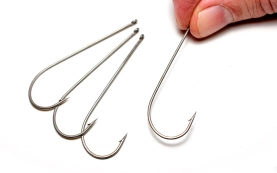










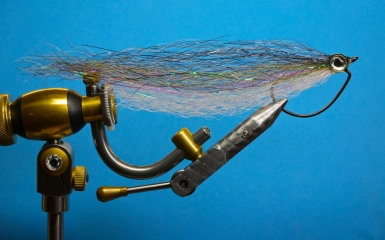






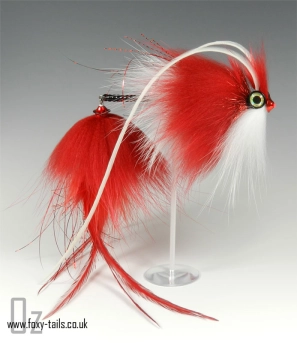
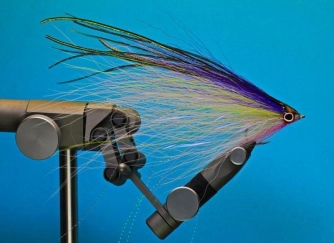

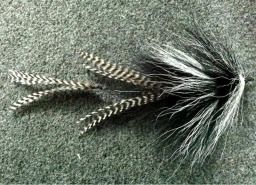




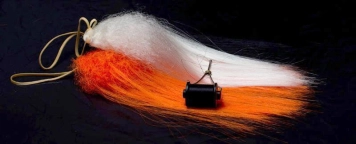


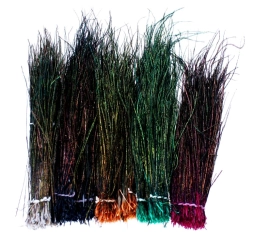



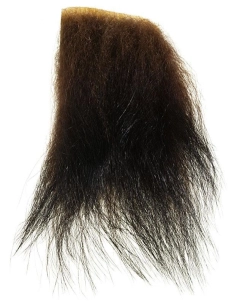



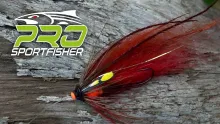




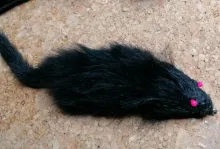

Nice article!
I tie
Nice article!
I tie some big flies myself for peacock and specially for payara. Its incredible how Little info on tying big, large yet light flies is there around the web. It is still a weird thing for people when I show them a 12" fly and I tell them I cast it with an 8 weight rod.
Amazing article!!!!!
Amazing article!!!!!!
Great article my bei
Great article my being a newbie to this stuff and also a late bloomer it's good to get insight on how to use a lot of things. I've recently done business with a guy in Montana website flytyersdungeon.com and he has a lot of synthetic stuff dyes and blends his own fresh or salt really easy to do business with--A big THANKS to his site I'm fortunate to live on a great smallmouth stream in the ozarks.
G'day Martin
G'day Martin
I go to school every time I read your articles Great stuff, enlightening content, and always a wonderful resource 'Keepupthegoodwork!!!
Cheeerz
Pete on the phrozen windswept shores of Kape Kodistan
Hello Martin,
Ver
Hello Martin,
Very good article and a load of very nice photo's and illustrations.
Best regards,
Tom Biesot.
Nils,
Thanks! Muc
Nils,
Thanks! Much appreciated, especially coming from you.
Martin
This is a exceptiona
This is a exceptional good article!
Nice, Martin. Big fl
Nice, Martin. Big flies for big fish. I'm a natural material guy, but I will investigate some of the lighter synthetics. Getting harder for the old goat to swing a big rod all day. ;-)
Great article on big fly tying
Martin .. a fabulous article on the root basics of tying big flies. I am passing this article around the horn. Great reference material here for all levels of fly-tying. Kudos! Another big winner. -AOF
Thanks
Les... eh... Arthur,
Thanks for the kind comment. And please spread the gospel!
Martin
Few things
Hair extentions dont work well. When wet they clump together. I havent tried waxing them yet but after the first cast, the large fly looks and turns over very poorly. The action in the water sucks too. I used Haloween neon blue and white i found at a party shop last year.
I found that tube bodies can be found on head gear in the Halloween isle at Wal-Mart last year for $2. Each head band has i believe four 18" tubes of different colors. The tubs have flash in them and they work great for all patterns that use tube bodies. Don't bother looking for them in Flemming Island. I buy buckets full.
Eyes are commonly found in craft sections as well. Flat-back gems and bedazzle stickers work well. I use a sharpie to make the pupil black. They are easy to use and i bought a jar full for $10, and its about 500 mixed size and color. Quality sticker gems work great too.
I found that dryer lint can be used as a fine dubbing if used in a dub loop.
Coat hanger, shrink wrap and a pen ink tube work well for bobbins if you are crafty. I used all homemade tools for years including a vice i made from scrap metal stock. Nothing is more rewarding than DIY plus Fly fishing
Things depend
Many of the hair extensions and the wig hairs suffer from the same syndrome as many commercial synthetic hairs: they felt. This doesn't go for all colors, kinds and brands, only some. You will have to test them before using them extensively. But that's also the case with what you buy in fly shops.
Regarding the rest of your advice, you are so right as we have already covered in several articles like these:
Inexpensive materials
Wash-n-Dry Dubbing
Martin
Great article
Fantastic article. I've only been tying Pike flies for a few years and this article opens up many new options for me. Thanks for the inspiration!!!!